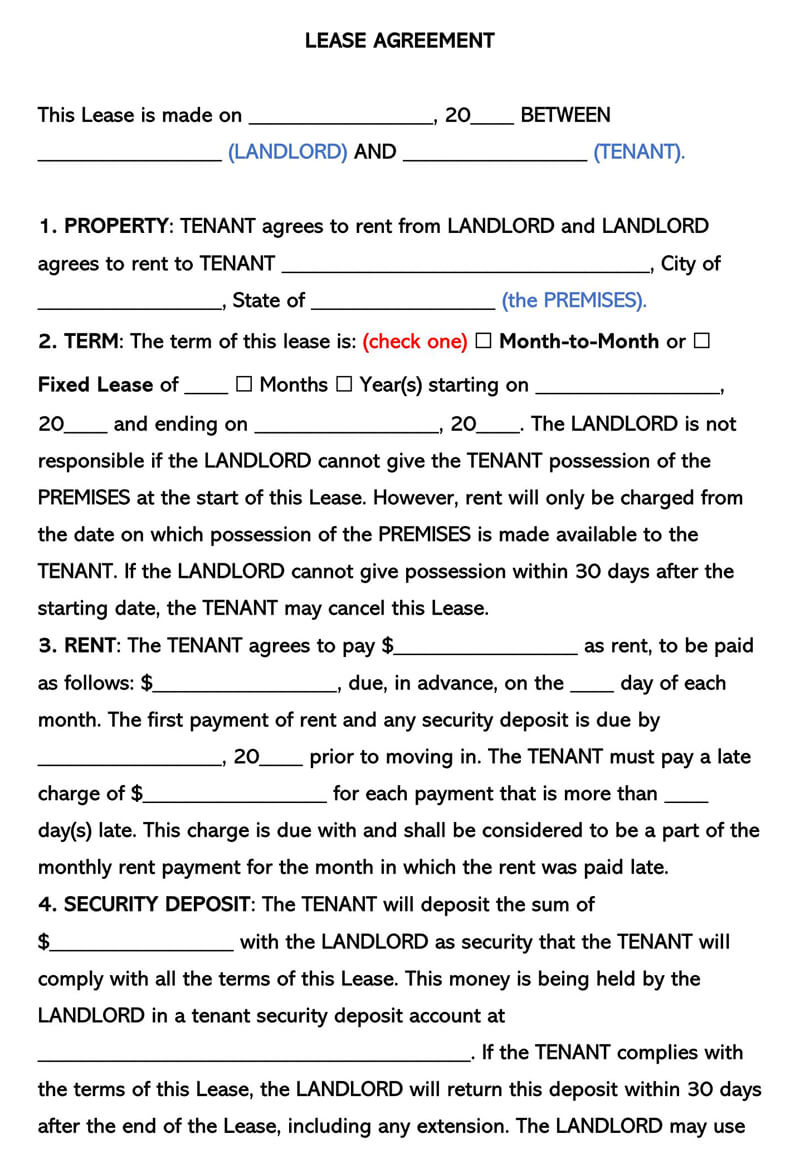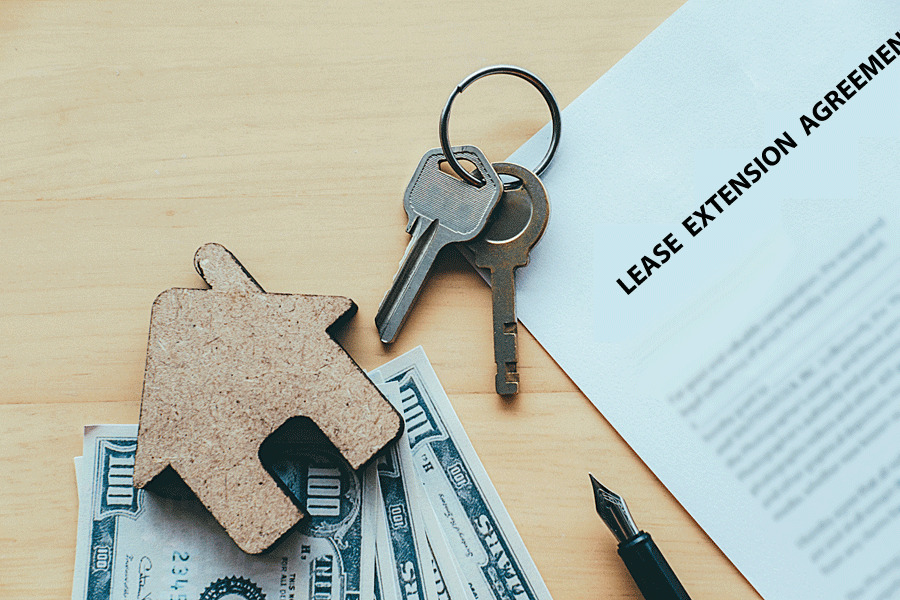One page lease agreement is a contract that is entered into between a landlord and a tenant. Technically.
A one-page lease agreement is a legally binding agreement between the Lessor (Landlord) and the Lessee (Tenant) to create a simple rental agreement when leasing out a residential real estate.
As its name implies, this lease is only one page long and is hence simpler to enact. Its whole life spans one month and covers such issues as the monthly rent payable, start and end dates, and the responsibilities that each party takes care of. It is employed for residential applications alone without any State disclosures.
Free One-Page Lease Agreement Template
Following are the free downloadable templates to be customized as per need:

One Page Lease Agreement – An Overview
It binds both the Landlord and the Tenant (s) to the full length of the lease. This agreement may be used for a fixed term or a month-to-month basis with general terms such as the monthly rent, the start and end dates of the lease, and utility clearly outlined. However, unlike a standard residential lease agreement, it contains a bare minimum for an effective lease, foregoing many clauses found in the standard lease agreements.
note
One lease agreement can only be used for residential purposes and does not include any required state disclosures.
Simple vs. Standard lease agreement
Although both the simple and standard lease agreement serve the same purpose, i.e., renting out an apartment, room, home, residential property, condominium, etc., to a tenant, they have key differences.
| Simple Lease Agreement | Standard Lease Agreement |
| Includes only what is necessary to bind the parties, i.e., the Landlord and the Tenant (s), into an effective agreement. | Covers all aspects, including pets, notices, Landlord’s agents, and other optional clauses. |
| Not all clauses are required to make a sound agreement. However, the parties involved must have mutual trust in each other. | All the clauses are required to make a sound agreement |
Usage of one page lease agreement
Three situations prompt one page lease agreement use. They include:
- Residential Lease Agreement: In this, the Tenant pays the Landlord to lease the property for residential purposes only.
- Commercial Lease Agreement: In this agreement, the Tenant pays the Landlord to use the rental premises for commercial purposes only.
- Sublease Agreement: In this agreement, the Tenant leases the property leased to them by the owner to another tenant either for residential or commercial purposes.
Disclosures
Most Federal, State and Local laws require landlords to disclose certain information and policies to the Tenant when leasing their property. Although these laws usually differ from one location to the other, they usually require the Landlord to make such disclosures before the Tenant moves in.
Some laws require that specific items be included in the lease agreement, such as;
Rental application
Before a landlord leases out a premise to a tenant, he has to screen the applicant to see to it that the applicant concerned meets all the thresholds and conditions necessary for staying on that premise. The ‘rental application’ endeavours to screen individuals to see to it that they meet the thresholds required.
Some of the areas inspected are criminal records, credit background checks, employment, and income levels. They are the ones that form the bedrock upon which the suitability of a tenant applicant is assessed.
Move-in disclosure
The move-in disclosure allows the Tenant to note any damages they find in the unit before moving in. It is the Tenant’s responsibility to fill in a move-in checklist and note the damages before moving in. The document must be returned to the Landlord, so they may not be charged for the listed damages when they decide to terminate the lease agreement and move out.
Lead-based paint disclosure
According to the lead-based paint disclosure, the Landlord must issue the Tenant with specific lead-based pamphlets and forms if the building was constructed before 1978.
Crafting a One Page Lease Agreement
There are various things that the Landlord should do before leasing their property, including screening the Tenant to make sure that they are who they say they are and they will be able to make timely payments on their rent.
Here is why the tenant should be screened before leasing:
Since these lease agreements are a simpler version of a more standard rental agreement, it does not include all the clauses as in standard agreements. These clauses are important for adding structure , which helps ensure that both parties understand their rights and what they can and cannot do once they have entered the agreement. One setback of having a broad agreement is that the Tenant can “act out” and then claim they didn’t see their actions as being against the rules .
To help reduce the chances of landing an unruly tenant, it is recommended that the Landlord makes use of rental applications, conducting paid background checks, contact references included in the rental application, and so on. With the rental application, the Landlord can get insight into the applicant’s previous renting experiences. If there are any red flags, the Landlord has enough time to decide whether to lease to the Tenant or reject their application.
Inspection
Before signing these lease agreement, it is important to inspect the property with the Tenant before entering into an agreement to lease. This will help the Tenant have a clear overview of the property and help them decide whether to lease or not.
It is important to have the Tenant during the inspection; however, if they are unable to make it during the inspection, organise with them to have somebody they trust to inspect the property on their behalf. Another great idea is to use a virtual tour of the premise through a video call with the Tenant.
If the method mentioned above is not viable to the Tenant, they can proceed to the next phase without inspecting the premises. However, they must be informed that doing so will be at their own risk.
The general list of things to be included in it as:
These things are explained below:
For the one page lease agreement to be binding, the following key items must be included:
- The parties: The names of all the parties involved, i.e., the lessor – landlord and the lessee – tenant
- The premises: The property and address of the subject being leased
- Rent: The rent amount to be paid by the Tenant and the frequency of payment
- Security deposit: The amount of money held in trust throughout the period of occupancy
- Landlord’s agent: The person who may act on his behalf when he is absent or out of touch.
- The terms: The duration of the lease, i.e., the start and end date
- Who settles the utility expenses like water, power, internet connectivity, garbage disposal, sewerage, and gas?
- Care and maintenance of the premises by both parties and what they handle
- How the destruction of the premises from such agents as damages, accidents, and third parties are handled
- Interruptions of services and how they are tackled if and when they arise
- Renewables of the charges and when the same might take effect
- Pets, whether they are allowed, which one you may bring along, and the way they have to be handled and preserved.
- Notices: how they are drafted, who drafts them, and how the same is delivered to the party concerned.
- Signatures: Signatures from both parties to officiate the lease
Here is How to Craft the One Page Lease Agreement
The parties
It should define the parties involved in the agreement to clearly establish their relationship. Information to be captured under the “Parties” provision include:
- Agreement Date: Include the date of the agreement. Usually, the date on which both parties signed the agreement
- Landlord Identity: The lessor, i.e., the party responsible for providing the premises to the Lessee, i.e., the Tenant, must be identified as the Property’s Landlord. This party can be the actual Landlord, i.e., the property owner who deals directly with the Tenants or the Agent or Property Management Company acting on behalf of the Landlord. Key details to be included about the landlord include; the Landlord’s legal name and the official mailing address where the Tenant can send in their correspondences.
- Tenant Information: The candidate approved for tenancy should be included in the agreement, i.e., their name, official mailing address, and other key identification details.
EXAMPLE
THE PARTIES. This lease agreement, herein referred to as “This Agreement or Agreement,” is made on this 1st April 20xx, between:
Landlord (lessor): ____________ [name] with a mailing address of _________________,
AND
Tenant(s) (Lessee): _______________ [name], with a mailing address of _________________________.
Collectively referred to as “The Parties.”
Lease type
Generally, there are two main options that one can decide on when leasing a property; fixed lease option and month-to-month lease.
- Fixed Lease Option: Most written usually remain in effect for a period of one year or longer and can only be terminated upon a certain set date. If one decides to use this option, then they should clearly indicate it in the lease agreement. They must also mention the start and end date of the lease agreement and mention conditions for the renewal of the agreement, if any.
EXAMPLE
LEASE TYPE. This agreement shall be considered a;
Fixed lease. The Lessee (Tenant) shall be allowed to occupy the premise as from the _____________ [date], and the lease shall end on the ___________ [date]. Should the Lessee wish to continue occupying the premises, they may continue leasing the premises under the same terms of this agreement under the month-to-month arrangement; otherwise, They must vacate the premises.
- Month-to-Month Lease: Short-term lease agreements, i.e. agreements that are less than a year, usually operate on a month-to-month basis. This implies that either party may terminate the agreement at any time by issuing a notice of a given number of days/weeks to the other. The actual number of days either party is supposed to issue when terminating the agreement should be stipulated in the lease agreement. Additionally, the agreement should state that the number of days either party will be required to issue the other notice of lease termination must be in line with the current statute of that state.
EXAMPLE
Month-to-Month lease. The Tenant shall be allowed to reside in the premises on a monthly arrangement starting on the _ date] and ending upon notice of [number of days] days from either party.
Payment terms
Key items to include in the agreement under the payment terms include:
- Monthly Rent Payment. The amount the Tenant will be required to pay the Landlord for them to be allowed to occupy the premises and the frequency and date for such payments.
EXAMPLE
The tenant will be required to pay a monthly rent of $_____ due on the __ [date] of each month.
- Security Deposit. Security deposits are usually made by a tenant and are used to cover any damages caused to the rental premises during the term of their lease. However, in most cases, the security deposit cannot be deducted to fix normal wear and tear. If the Tenant is required to pay a security deposit, the exact amount required and the terms governing how the security deposit will be used or reimbursed should be mentioned in the agreement.
EXAMPLE
The Tenant will pay a one-off security deposit of $__ due at signing
- Last Month’s Rent. If the Tenant is required to pay the last month’s rent before signing the lease, this information should be included in the lease agreement. This will help the Tenant calculate the total amount they are supposed to furnish themselves with before signing the agreement. The last month’s rent is usually required to protect the Landlord from the Tenant abandons the premises without notice or in mid-term.
EXAMPLE
The Tenant will pay the last month’s rent of $_____ due at the signing.
Additional requirements
Leave several blank spaces for any additional information required, such as extra payments made by the Tenant, additional fees charged. It is important to document everything in the lease agreement as such documents may be presented in court should there arise any disagreements regarding the lease.
EXAMPLE
______________: $ Due ____
______________: $ Due ____
______________: $ Due ____
Utilities
Utilities are the general items needed for the smooth day-to-day operations of the party leasing the premises. The agreement should distinctively outline the utilities that either party will have to cater for during the lease term.
- Utility Exception: It is usually the Tenant’s responsibility to obtain and maintain basic services and utilities for their day-to-day activities during the duration of their leases, such as waste disposal, electricity, and on-site security. In some cases, the Landlord may have special services and utilities that they may choose to cater for during the lease term. For example, the Landlord may cover general services such as landscaping and maintenance of the premises. If this is the case, then the agreement should include all utilities covered by the Landlord.
EXAMPLE
UTILITIES: The Tenant shall be required to cater for all utilities and services to the premises except for:
____________
____________
____________
____________
Other Terms
Other provisions that the Tenant should know about when entering the agreement should be included under the “Other Terms” provision, including the state laws that will govern the agreement and any necessary disclosures.
- Agreement Provisions: All the basic requirements that must be fulfilled by both the Tenant and the Landlord taking part in the lease agreement must be considered and captured. Also, make sure to capture any additional requirements set by the local laws with regards to the leasing of properties. For instance, in some municipalities, the Landlord may be required to disclose all attachments made for the properties that required mould treatment, while the federal government may require that they provide lead paint disclosure for properties built before 1976. Additionally, any additional paperwork or obligation not considered part of the lease agreement should be documented in this section. Neither the Lessee nor the Lessor will be required to live up to terms not included in the agreement.
Party signatures
- Landlord’s Signature. The lease agreement can only be considered valid upon signing by both parties involved. To show that they acknowledge this document, the Landlord must sign and print their name to complete the document.
- Tenant’s Signature. After going through the document and agreeing to the terms, the Tenant must sign their name and include their print name.
EXAMPLE
Landlord’s Signature: __________________
Print Name: _________________
Tenant’s Signature: ___________________
Print Name: ______________
Frequently Asked Questions
It is recommended that both the lessor and the Lessee meet and sign a hard copy document rather than use email for such correspondence. However, since lease agreements are based on existing trust between both parties, opting for email correspondence in such cases may be a viable option and can hence be used as proof.
Yes. Anyone can craft a lease agreement. It is important, however, to ensure that all-important clauses are well captured in the document.
Once the lessor and the Lessee sign the lease agreement, and a copy is delivered to both of them, the agreement becomes binding, and breaking or cancelling it without following the terms of the agreement can invite legal actions and fines, which may be costly to the party in breach of the agreement.
A rental agreement is very similar to a lease agreement. The biggest difference between the lies in the length of the
agreement. Unlike a lease agreement, rental agreements provide tenancy for a shorter period, usually 30 days.











